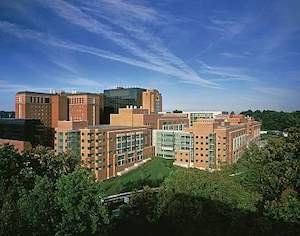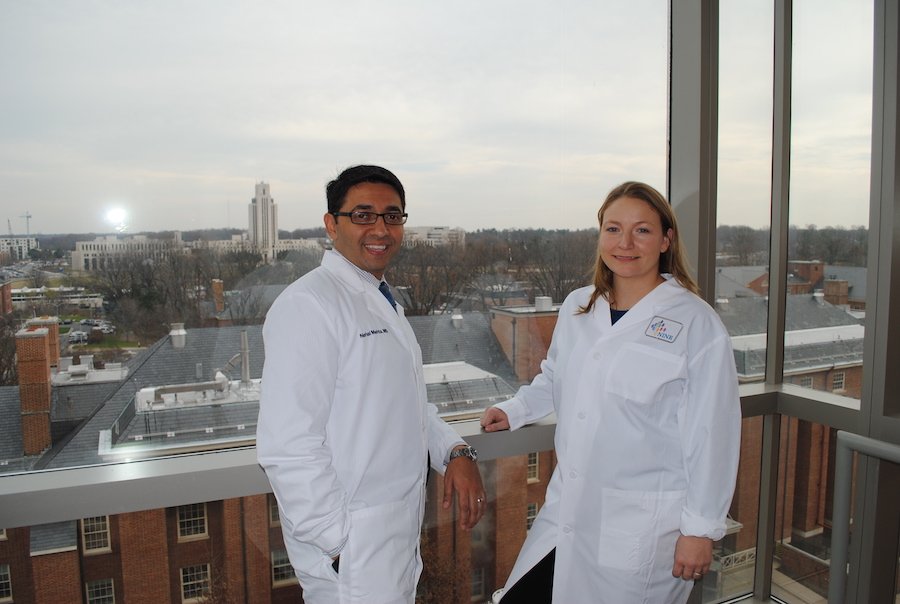Finding time for research can be challenging for a physician who typically has a large patient load and other clinical responsibilities. But for the 23 scientists in the Lasker Clinical Research Scholars program, including the eight recently announced 2018 scholars, ambitious patient-centered research projects are front and center, and careers in clinical research are on the fast track.

NIH Clinical Research Center
The Lasker Clinical Research Scholars program, which appointed its first cohort in 2012, gives early-stage clinician-investigators tenure-track positions, along with guaranteed research funding, in one of the NIH institutes or centers for five years, with the possibility of a two-year extension. At the end of this intramural phase, they have the choice to apply for tenure at the NIH, with guaranteed funding, or seek a position outside the NIH and apply for three years of extramural funding.
"The idea for this program was that clinicians, having seen a lot of patients, frequently have a sense of what may lead to direct improvements for human health, so we wanted to encourage them to do research." Charles R. Dearolf, director of program development and support in the NIH Office of Intramural Research.
Over the last several decades, the number of physicians who primarily do research has been shrinking. Funding is difficult to obtain, and many choose other paths such as going into private practice, Dearolf explains. The NIH partnered with the Lasker Foundation to create the Clinical Research Scholars program to encourage top-notch physician-scientists to stay in research.
For Nehal Mehta, one of the program's two inaugural scholars, the decision to accept the appointment and move from his position as an assistant professor at the University of Pennsylvania in 2012 was a "no-brainer." In addition to the guaranteed funding, scholars can also apply for additional research money, and these proposals are typically reviewed in a more rapid fashion than traditional RO1-type grants according to Mehta. Through this process, Mehta has secured four RO1-sized grants. "The Lasker Clinical Research Scholars program has literally accelerated my trajectory exponentially," he says.

Nehal Mehta (left) and Jessical Gill (credit Nick Zagorski)
Now that Mehta, who is in the National Heart, Lung, and Blood Institute at the NIH, has committed to stay at the NIH (he is up for tenure in April), he has received resources to conduct a clinical trial of patients at the NIH Clinical Center to test the observation that an immunosuppressive drug for treating psoriasis, can reduce the progression of coronary artery disease.
Although most of the current scholars have MD degrees, the program is expanding the concept of clinician-researchers beyond just physicians. Jessica Gill, who has an RN and a PhD, was awarded a tenured position in the National Institute of Nursing Research last June. "The focus of our Institute is developing an example that can be used across the country of how to do amazing nursing-led research," says Gill, who is now also the deputy director of her Institute, which holds workshops and programs to give nurses research experience.
Gill, like other scholars in the program, continues to see patients, but they are receiving care at the NIH Clinical Center specifically for conditions related to her research. For one of her projects, she studies athletes and people from the military who have endured mild or repetitive brain injuries. She performs brain imaging and measures proteins in the subjects' blood to try to understand their recovery process. Her ultimate goal is to predict who will have delays in recovering. For Gill, being at the NIH streamlines collaborations with other NIH researchers, as well as groups such as the National Collegiate Athletic Association. Being a Lasker Clinical Research Scholar opened those doors even wider.
Jing Wu, who was just appointed to the program in July as part of the most recent scholar cohort, is already benefiting from the support staff for clinical research, including study nurses and the members of the protocol office. Part of her research as a scholar will involve sophisticated neuroimaging of patients with gliomas that harbor a mutation in a gene called IDH to detect when their disease is becoming aggressive. At that point, she and her team will perform brain biopsies to study the molecular and metabolic changes that underlie disease progression.
Before moving to the NIH, Wu was an assistant professor at the University of North Carolina, which she calls a "great institution." But she was always wishing for more time to do research. "Taking care of patients day after day is great, but I don't think it's very efficient in terms of finding new therapies to better help the patients," she says. As a Lasker Clinical Research Scholar, she has the opportunity to do just that and ultimately hopes to discover curative therapies for brain cancers.
by Carina Storrs
